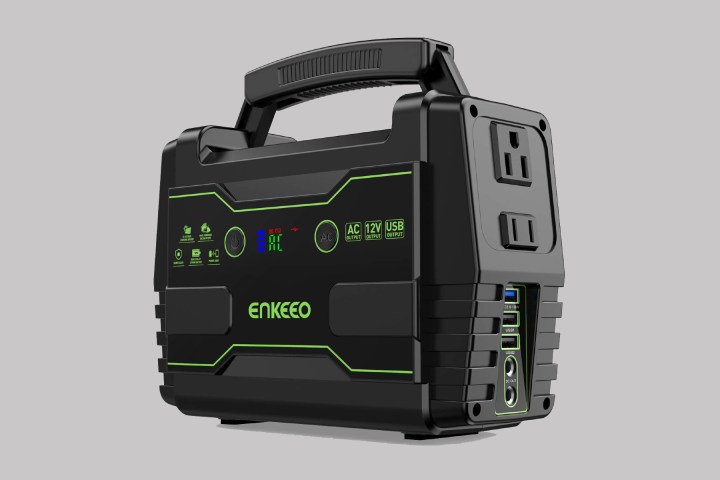Portable power stations are versatile devices that can keep electronics and small appliances running when you’re camping, traveling, attending sports events, and during unexpected power outages. Amazon featured two Jackery devices during today’s 12 Days of Deals and Enkeeo has coupon deals on three portable power alternatives.
Strictly speaking, portable power stations range from a pocket-sized USB charger to rolling gas-powered generators. The deals in the post include Lithium-ion battery packs with one or more AC power outlets, a gasoline-powered inverter generator, and a folding solar panel that can recharge personal electronics as well as the Lithium power stations. Whether you’re buying Christmas gifts, want a temporary backup power source for your smart home, or looking for a convenient way to bring power to tailgates, these five deals can help you save up to $200.
Jackery Portable Power Station Explorer 240 — $75 off
The Jackery Portable Power Station Explorer 240 Lithium-ion battery pack stores up to 240 watt-hours of power (67,000mAh). You can plug in small appliances into the single AC outlet, two USB-A ports, or one 12V DC car outlet. According to Jackery, the Explorer 240 can power a 40-watt LED lamp for up to 40 hours, recharge a smartphone 20 times, or run a 40-watt mini fridge for up to 5 hours. You can recharge the Explorer in 7-to-8 hours with standard AC power, from a car power outlet, or a portable solar panel such as Jackery’s SolarSaga 60 below. The Jackery Explorer 240 weighs 6.6 pounds and measures 9.05 inches wide by 5.24-inches deep by 7.87 inches high.
Normally priced at $250, the Jackery Portable Power Station Explorer 240 is just $175 during this 24-hour sale that ends at midnight P.T tonight.
Enkeeo Portable Power Station 155W — $38 off
The Enkeeo Portable Power Station 155W weighs 3.7 pounds and measures 8.35 inches wide by 3.62 inches deep by 7.4 inches high. This 43,000mAh Lithium-ion battery power station supplies 155 watt-hours of power via two standard AC outlets (one 3-prong and one 2-prong), three USB ports (one 3A quick charge), and two DC power jacks. Recharging from AC power takes about seven hours, and you can also recharge the Enkeeo 115W from a 12V car power socket or a compatible solar panel with power output ranging from 50 to 100 watts. Cables for all three means of recharging are included. The Enkeeo also has an integrated LED flashlight on one end.
Usually $110, the Enkeeo Portable Power Station 155W is just $72 when you use two discount codes. Get $22 off by checking the box on the product page and an additional $16 off by using the discount code LZKKHO5H during checkout. This deal works until December 20, 11:59 p.m. PT.
Enkeeo Portable Power Station 222W — $50 off
The Enkeeo Portable Power Station 222W is similar to, but provides more power and has more outlets than, the 155W model above. The 61,600mAh Lithium-ion battery in the 222W powers two AC jacks (one 3-prong and one 2-prong), six USB ports (four Type A and two Type C), and three 12V DC jacks. The Enkeeo 222W weighs 5 pounds and measures 9.45 inches wide by 4.29 inches deep by 8.36 inches high.
Regularly priced $190, the ENKEEO Portable Power Station 222W is just $140 when you check the $50 discount box on the product page. This deal ends at 11:59 p.m. PT on Dec. 21.
Jackery SolarSaga 60W Solar Panel — $54 off
The Jackery SolarSaga 60W Solar Panel is primarily intended to charge Jackery’s Explorer power stations, but it can work independently to charge smartphones and other portable electronics with one USB Type C port and one USB Type A port. Rated at 23% solar charging efficiency, the 60-watt SolarSaga weighs 3.3 pounds. Foldable for portability, the device has an included adjustable kickstand.
Ordinarily $180, the Jackery SolarSaga 60W Solar Panel is just $156 until midnight tonigh, Dec. 14.
Enkeeo 2300W Portable Inverter Generator — $200 off
Stepping up from the Lithium-ion and solar-powered devices above, the Enkeeo 2300W Portable Inverter Generator runs on gasoline. The 2300W has a 1.1-gallon gas tank and can run from 4-to-12 hours depending on demand. Unlike gas generators, which are much noisier, run at constant speeds, and are subject to power level fluctuations, inverter generators are relatively quiet and provide cleaner, more stable power that won’t harm electronic devices.
Packing more than ten times the power of the Enkeeo 222W portable power station above, the 23ooW Inverter can be linked in parallel with additional units via an included cable if you want even more power. An LED display keeps you up to date with fuel, voltage, running hours, and maximum power. The Enkeeo measures 22.3 inches deep by 16.9 inches wide by 21.4 inches high and weighs 50.6 pounds. There is a carrying handle on top, but you also can pull out a top-front-mounted handle to roll the unit on integrated wheels.
Instead of the usual $600 price, the Enkeeo 2300W Portable Inverter Generator is $400 during this sale when you click the discount code box on the product page. This deal expires at midnight Pacific Time, December 20.
Editors' Recommendations
- Segway expands its smart home footprint with robot lawn mowers at CES 2024
- Anker reveals Solix C1000 and Solix F3800 portable power stations
- EcoFlow launches Delta 2 Max solar generator for home emergencies and outdoor adventures
- Portable wind turbines, solar tent, rolling battery round out Jackery’s CES 2023 launches
- Bluetti Bucks: Earn rewards and discounts on charging gear












